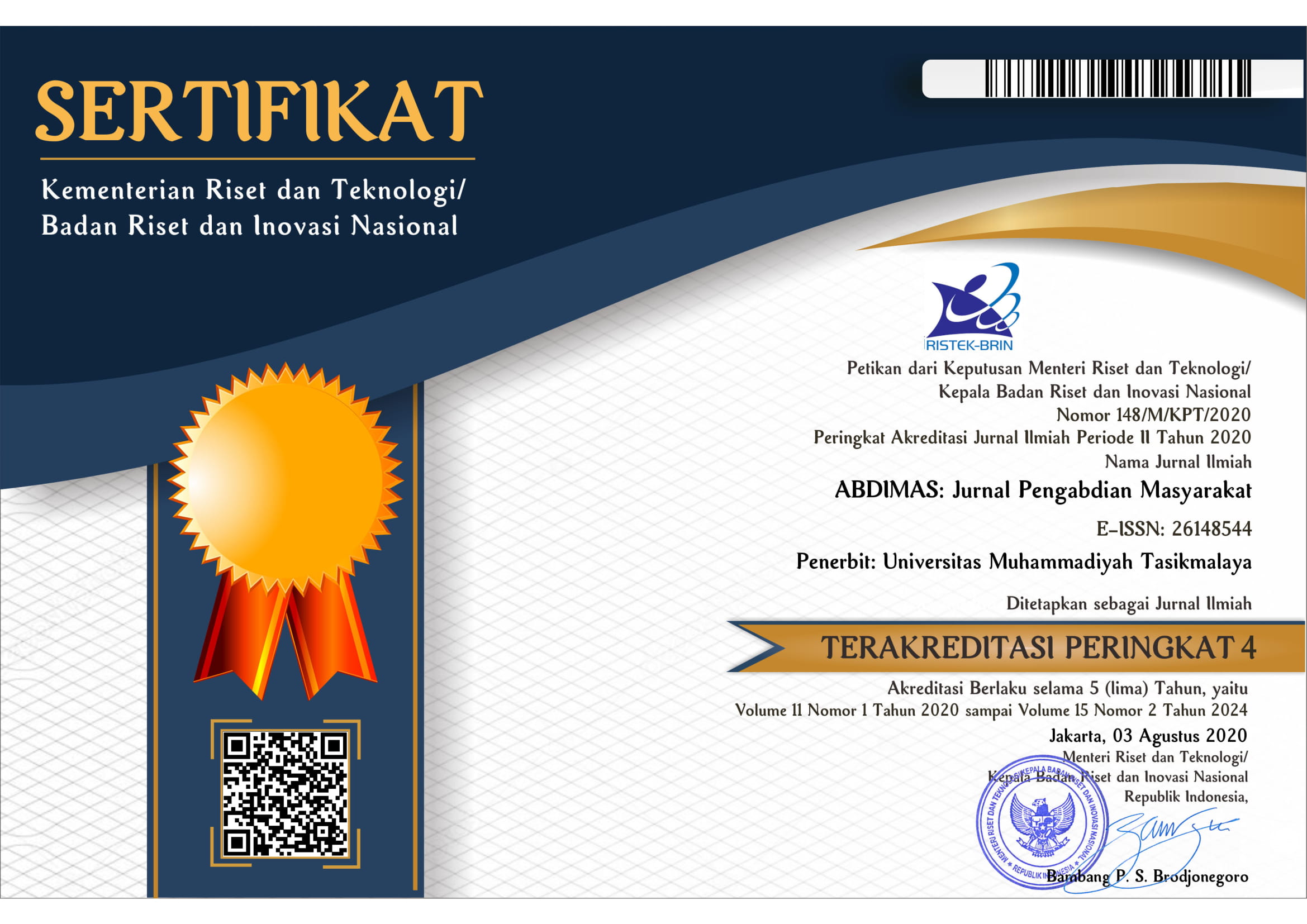Stunting Reduction: TTS District Community Empowerment Based on Local Wisdom
DOI:
https://doi.org/10.35568/abdimas.v7i1.4446Keywords:
Local Wisdom, NTT, Stunting, TTSAbstract
Stunting has become a serious problem today. Data shows that East Nusa Tenggara (NTT) Province first ranks in stunting nationally. Based on the 2021 Indonesian Nutritional Status Study (SSGI), 15 districts in NTT are categorized as red (stunting prevalence >30%). South Middle East (TTS) and North Middle East (TTU) districts have a prevalence of >46%. This study aims to discuss the model of community empowerment in dealing with stunting which has become a serious problem today in South Middle East District (TTS). The method used is direct education (a method that involves delivering information and knowledge directly to individuals or groups). The results show that community empowerment to reduce stunting is a collective work between pentahelix elements, community empowerment programs in Haumenbaki Village rely on the strength of local wisdom, namely manonop (cooperation) and three important actors of community empowerment elements in Haumenbaki Village, namely the community, village government, and external institutions (agencies, universities, NGOs, and the media).
Downloads
References
Achmad, W. (2023). Community Empowerment Plan in Overcoming Malnutrition. Journal Sampurasun : Interdisciplinary Studies for Cultural Heritage, 9(1), 45–52. https://doi.org/10.23969/sampurasun.v9i1.7523
Afandi, M. N., Tri Anomsari, E., Novira, A., & Sudartini, S. (2023). Collaborative governance in a mandated setting: shifting collaboration in stunting interventions at a local level. Development Studies Research, 10(1). https://doi.org/10.1080/21665095.2023.2212868
Annisa, L., & Sulistyaningsih, S. (2022). The Empowerment of Family in Effort to Reduce Stunting in Under-Five Children: A Scoping Review. Jurnal Aisyah : Jurnal Ilmu Kesehatan, 7(2), 451–460. https://doi.org/10.30604/jika.v7i2.1006
Bahrun, & Wildan. (2022). Stunting in Indonesian Children and Its Contributing Factors: Study through Bibliometric Analysis. JPUD - Jurnal Pendidikan Usia Dini, 16(2), 271–293. https://doi.org/10.21009/jpud.162.07
de Onis, M., & Branca, F. (2016). Childhood stunting: a global perspective. Maternal & Child Nutrition, 12(Suppl 1), 12. https://doi.org/10.1111/MCN.12231
Diana, R., Rachmayanti, R. D., Khomsan, A., & Riyadi, H. (2022). Influence of eating concept on eating behavior and stunting in Indonesian Madurese ethnic group. Journal of Ethnic Foods, 9(1), 1–11. https://doi.org/10.1186/S42779-022-00162-3/FIGURES/5
Effran, E., Perdana, M., Maranting, H., & Prakoso, T. (2023). Manajemen Strategi Agribisnis. https://www.google.com/books?hl=en&lr=&id=_LnMEAAAQBAJ&oi=fnd&pg=PR5&dq=Manajemen+Strategi+Agribisnis&ots=00Btb1fs5V&sig=0SXMGE1K5wEJv3Qix9jD4rBctrw
Ellitan, L. (2020). Competing in the era of Industrial Revolution 4.0 and society 5.0. Jurnal Maksipreneur, 10(1), 1–12. https://doi.org/10.30588/jmp.v10i1.657
Elsye, R. (2020). Improvement of Community Economy through Community Empowerment in the Cultivation of Competitive Ornamental Fish in Bogor Regency. Talent Development & Excellence, 12(1), 3883–3898. http://search.ebscohost.com/login.aspx?direct=true&db=s3h&AN=144307426&lang=ja&site=ehost-live
Herwina, W., & Mustakim, M. (2019). Business and Industry World Contributions to Community Empowerment. Journal of Nonformal Education, 5(1), 79–88. https://doi.org/10.15294/jne.v5i1.18342
Mentari, W. D., & Muhammad, S. (2023). Prevention of Stunting Counselling for Pregnant Mother and Mother with Toddler. ABDIMAS: Jurnal Pengabdian …. https://journal.umtas.ac.id/index.php/ABDIMAS/article/view/3179%0Ahttps://journal.umtas.ac.id/index.php/ABDIMAS/article/download/3179/1578
Nalle, F. W., Sengkoen, Y., Seran, R. B., & Rahmarini, W. A. (2023). Regional development disparity and mapping of economic potential in East Nusa Tenggara province. JPPI (Jurnal Penelitian Pendidikan Indonesia), 9(2), 669. https://doi.org/10.29210/020232354
Prendergast, A. J., & Humphrey, J. H. (2014). The stunting syndrome in developing countries. Paediatrics and International Child Health, 34(4), 250–265. https://doi.org/10.1179/2046905514Y.0000000158
Ramadhan, Y., Sirait, R. B., Chusanudin, A., Longa, E., & Kurniawati, D. (2022). The Role of Strategic Management Accounting In The Development of Sustainable Development Goals (SDGs) In The Field of Decent Work To Support The Economic Growth of Ntt Province. Journal Research of Social Science, Economics, and Management, 2(03), 358–367. https://doi.org/10.59141/jrssem.v2i03.286
Riwu, Y. F., Gaina, C. D., & Loe, F. R. (2023). Financial Governance Management for Farmers, Ranchers, and Weavers of Camplong Ii Village, Kupang Regency. ABDIMAS: Jurnal Pengabdian Masyarakat, 6(4), 4614–4621. https://doi.org/10.35568/ABDIMAS.V6I4.3974
Sinuraya, K. R., Qodrina, A. H., & Amalia, R. (2019). Peningkatan Pengetahuan Masyarakat Dalam Mencegah Stunting. Jurnal Pengabdian Kepada Masyarakat, 4(2), 48–51. https://jurnal.unpad.ac.id/pkm/article/view/23242
Sugiyono. (2018). Metode Penelitian Kuantitatif Kualitatif dan R & D. https://openlibrary.telkomuniversity.ac.id/home/catalog/id/10026/slug/metode-penelitian-kuantitatif-kualitatif-dan-r-d.html
Suryana, E. A., & Azis, M. (2023). the Potential of Economic Loss Due To Stunting in Indonesia. Jurnal Ekonomi Kesehatan Indonesia, 8(1), 52. https://doi.org/10.7454/eki.v8i1.6796
Torlesse, H., Cronin, A. A., Sebayang, S. K., & Nandy, R. (2016). Determinants of stunting in Indonesian children: Evidence from a cross-sectional survey indicate a prominent role for the water, sanitation and hygiene sector in stunting reduction. BMC Public Health, 16(1), 1–11. https://doi.org/10.1186/S12889-016-3339-8/TABLES/4
Vaivada, T., Akseer, N., Akseer, S., Somaskandan, A., Stefopulos, M., & Bhutta, Z. A. (2020). Stunting in childhood: an overview of global burden, trends, determinants, and drivers of decline. The American Journal of Clinical Nutrition, 112(Suppl 2), 777S. https://doi.org/10.1093/AJCN/NQAA159














